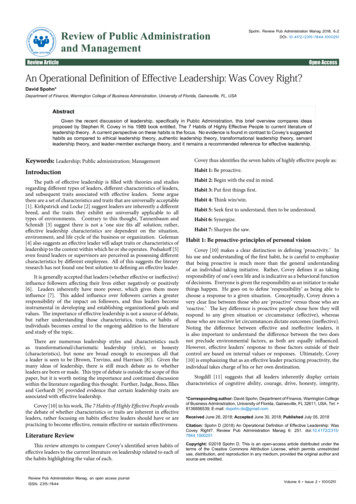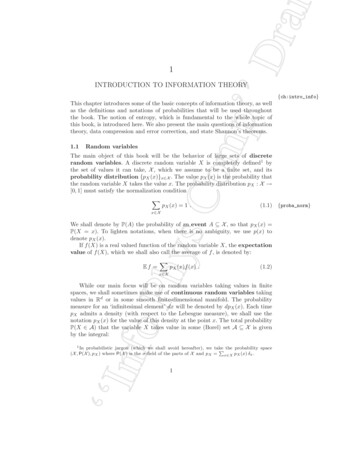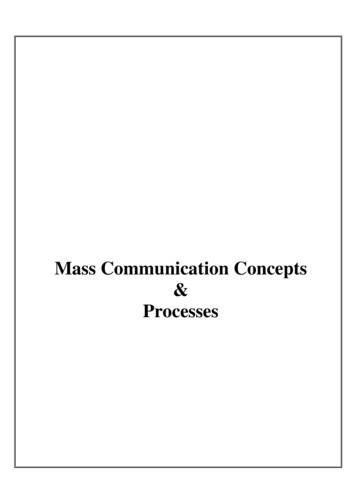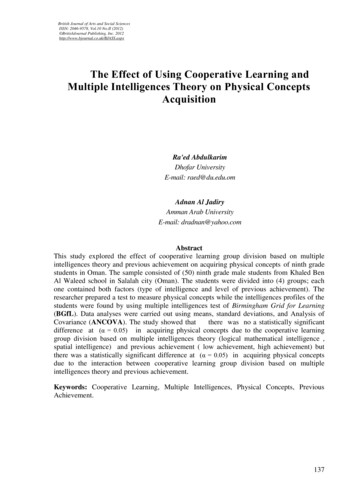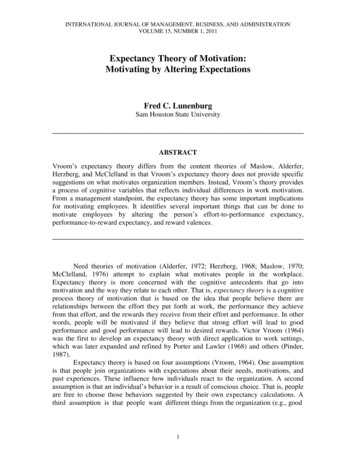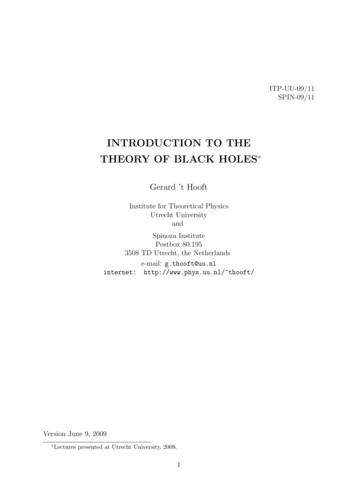
Transcription
ITP-UU-09/11SPIN-09/11INTRODUCTION TO THETHEORY OF BLACK HOLES Gerard ’t HooftInstitute for Theoretical PhysicsUtrecht UniversityandSpinoza InstitutePostbox 80.1953508 TD Utrecht, the Netherlandse-mail: g.thooft@uu.nlinternet: http://www.phys.uu.nl/ thooft/Version June 9, 2009 Lectures presented at Utrecht University, 2009.1
Contents1 Introduction22 The Metric of Space and Time43 Curved coordinates54 A short introduction to General Relativity65 Gravity96 The Schwarzschild Solution107 The Chandrasekhar Limit138 Gravitational Collapse149 The Reissner-Nordström Solution1810 Horizons2011 The Kerr and Kerr-Newman Solution2212 Penrose diagrams2313 Trapped Surfaces2514 The four laws of black hole dynamics2915 Rindler space-time3116 Euclidean gravity3217 The Unruh effect3418 Hawking radiation3819 The implication of black holes for a quantum theory of gravity4020 The Aechelburg-Sexl metric441
21 History1.47IntroductionAccording to Newton’s theory of gravity, the escape velocity v from a distance r fromthe center of gravity of a heavy object with mass m , is described by1 2v2 Gm.r(1.1)What happens if a body with a large mass m is compressed so much that the escapevelocity from its surface would exceed that of light, or, v c ? Are there bodies with amass m and radius R such that2G m 1?R c2(1.2)This question was asked as early as 1783 by John Mitchell. The situation was investigatedfurther by Pierre Simon de Laplace in 1796. Do rays of light fall back towards the surfaceof such an object? One would expect that even light cannot escape to infinity. Later, itwas suspected that, due to the wave nature of light, it might be able to escape anyway.Now, we know that such simple considerations are misleading. To understand whathappens with such extremely heavy objects, one has to consider Einstein’s theory ofrelativity, both Special Relativity and General Relativity, the theory that describes thegravitational field when velocities are generated comparable to that of light.Soon after Albert Einstein formulated this beautiful theory, it was realized that hisequations have solutions in closed form. One naturally first tries to find solutions withmaximal symmetry, being the radially symmetric case. Much later, also more generalsolutions, having less symmetry, were discovered. These solutions, however, showed somefeatures that, at first, were difficult to comprehend. There appeared to be singularitiesthat could not possibly be accepted as physical realities, until it was realized that at leastsome of these singularities were due only to appearances. Upon closer examination, itwas discovered what their true physical nature is. It turned out that, at least in principle,a space traveller could go all the way in such a “thing” but never return. Indeed, alsolight would not emerge out of the central region of these solutions. It was John ArchibaldWheeler who dubbed these strange objects “black holes”.Einstein was not pleased. Like many at first, he believed that these peculiar featureswere due to bad, or at least incomplete, physical understanding. Surely, he thought,those crazy black holes would go away. Today, however, his equations are much betterunderstood. We not only accept the existence of black holes, we also understand howthey can actually form under various circumstances. Theory allows us to calculate the2
behavior of material particles, fields or other substances near or inside a black hole. Whatis more, astronomers have now identified numerous objects in the heavens that completelymatch the detailed descriptions theoreticians have derived. These objects cannot beinterpreted as anything else but black holes. The “astronomical black holes” exhibit noclash whatsoever with other physical laws. Indeed, they have become rich sources ofknowledge about physical phenomena under extreme conditions. General Relativity itselfcan also now be examined up to great accuracies.Astronomers found that black holes can only form from normal stellar objects if theserepresent a minimal amount of mass, being several times the mass of the Sun. For lowmass black holes, no credible formation process is known, and indeed no indications havebeen found that black holes much lighter than this “Chandrasekhar limit” exist anywherein the Universe.Does this mean that much lighter black holes cannot exist? It is here that one couldwonder about all those fundamental assumptions that underly the theory of quantummechanics, which is the basic framework on which all atomic and sub-atomic processesknown appear to be based. Quantum mechanics relies on the assumption that everyphysically allowed configuration must be included as taking part in a quantum process.Failure to take these into account would necessarily lead to inconsistent results. Miniblack holes are certainly physically allowed, even if we do not know how they can beformed in practice. They can be formed in principle. Therefore, theoretical physicistshave sought for ways to describe these, and in particular they attempted to include themin the general picture of the quantum mechanical interactions that occur in the sub-atomicworld.This turned out not to be easy at all. A remarkable piece of insight was obtainedby Stephen Hawking, who did an elementary mental exercise: how should one describerelativistic quantized fields in the vicinity of a black hole? His conclusion was astonishing.He found that the distinction between particles and antiparticles goes awry. Different observers will observe particles in different ways. The only way one could reconcile this withcommon sense was to accept the conclusion that black holes actually do emit particles, assoon as their Compton wavelengths approach the dimensions of the black hole itself. Thisso-called “Hawking radiation” would be a property that all black holes have in common,though for the astronomical black holes it would be far too weak to be observed directly.The radiation is purely thermal. The Hawking temperature of a black hole is such thatthe Wien wave length corresponds to the radius of the black hole itself.We assume basic knowledge of Special Relativity, assuming c 1 for our unit systemnearly everywhere, and in particular in the last parts of these notes also Quantum Mechanics and a basic understanding at an elementary level of Relativistic Quantum Field Theoryare assumed. It was my intention not to assume that students have detailed knowledge ofGeneral Relativity, and most of these lectures should be understandable without knowingtoo much General Relativity. However, when it comes to discussing curved coordinates,Section 3, I do need all basic ingredients of that theory, so it is strongly advised to familiarize oneself with its basic concepts. The student is advised to consult my lecture notes“Introduction to General Relativity”, http://www.phys.uu.nl/ thooft/lectures/genrel.pdf3
whenever something appears to become incomprehensible. Of course, there are numerousother texts on General Relativity; note that there are all sorts of variations in notationused.2.The Metric of Space and TimePoints in three-dimensional space are denoted by a triplet of coordinates, x (x, y, z) ,which we write as (x1 , x2 , x3 ) , and the time at which an event takes place is indicatedby a fourth coordinate t x0 /c , where c is the speed of light. The theory of SpecialRelativity is based on the assumption that all laws of Nature are invariant under a specialset of transformations of space and time: 0 0 ta 0 a01 a02 a03t a10 a11 a12 a13 x x0 0 2 y a 0 a21 a22 a23 y ,z0a30 a31 a32 a33zXorxµ 0 aµν xν ,orx0 A x ,(2.1)ν 0,···,3provided that the matrix A is such that a special quantity remains invariant: c2 t02 x02 y 02 z 02 c2 t2 x2 y 2 z 2 ;which we also write as:X gµν xµ xν is invariant, gµνµ,ν 0,···,3 1 0 0001000010(2.2) 00 .0 1(2.3)A matrix A with this property is called a Lorentz transformation. The invariance isLorentz invariance. Usually, we also demand thata00 0 ,det(A) 1 ,(2.4)in which case we speak of special Lorentz transformations. The special Lorentz transformations form a group called SO(3, 1) .In what follows, summation convention will be used: in every term of an equationwhere an index such as the index ν in Eqs. (2.1) and (2.3) occurs exactly once as asuperscript and once as a subscript,this index will be summed over the values 0, · · · , 3 ,Pso that the summation sign,, does not have to be indicated explicitly anymore: xµ 0 aµν xν and s 2 gµν xµ xν . In the latter expression, summation convention has beenimplied twice.More general linear transformations will turn out to be useful as well, but then (2.2)will not be invariant. In that case, we simply have to replace gµν by an other quantity,as follows:0gµν (A 1 )αµ (A 1 )βν gαβ ,4(2.5)
so that the expression0s2 gµν xµ xν gµνxµ 0 xν 0(2.6)remains obviously valid. Thus, Nature is invariant under general linear transformationsprovided that we use the transformation rule (2.5) for the tensor gµν . This tensor willthen be more general than (2.3). It is called the metric tensor. The quantity s definedby Eq. (2.6) is assumed to be positive (when the vector is spacelike), i times a positivenumber (when the vector is timelike), or zero (when xµ is lightlike). It is then called theinvariant length of a Lorentz vector xµ .In the general coordinate frame, one has to distinguish co-vectors xµ from contravectors xµ . they are related byxµ gµν xν ;xµ g µν xν ,(2.7)where g µν is the inverse of the metric tensor matrix gµν . Usually, they are denoted bythe same symbol; in a vector or tensor, replacing a subscript index by a superscript indexmeans that, tacitly, it is multiplied by the metric tensor or its inverse, as in Eqs. (2.7).3.Curved coordinatesThe coordinates used in the previous section are such that they can be used directly tomeasure, or define, distances and time spans. We will call them Cartesian coordinates.Now consider just any coordinate frame, that is, the original coordinates (t, x, y, z) arecompletely arbitrary, in general mutually independent, differentiable functions of fourquantities u {uµ , µ 0, · · · , 3} . Being differentiable here means that every point issurrounded by a small region where these functions are to a good approximation linear.There, the formalism described in the previous section applies. More precisely, at agiven point x in space and time, consider points x dx , separated from x by only aninfinitesimal distance dx . Then we define ds by0ds2 gµν dxµ dxν gµν(u) duµ duν .(3.1)The prime was written to remind us that gµν in the u coordinates is a different functionthan in the x coordinates, but in later sections this will be obvious and we omit theprime. Under a coordinate transformation, gµν transforms as Eq. (2.5), but now thesecoefficients are also coodinate dependent:0gµν(u) xα xβgαβ (x) . uµ uν(3.2)In the original, Cartesian coordinates, a particle on which no force acts, will go along astraight line, which we can describe asdxµ (τ ) v µ constant;dτv µ v µ 1 ;5d2 xµ (τ ) 0,dτ 2(3.3)
y′yx′xFigure 1: A transition from one coordinate frame {x, y} to an other, curvedcoordinate frame {x0 , y 0 } .where τ is the eigen time of the particle. In terms of curved coordinates uµ (x) , this nolonger holds. Suppose that xµ are arbitrary differentiable functions of coordinates uλ .Thendxµ xµ duλd 2 xµ 2 xµ duκ duλ xµ d2 uλ ; λ.dτ uλ dtdτ 2 uλ uκ dτ dτ u dτ 2Therefore, eq. (3.3) is then replaced by an equation of the formduµ duνd2 uµ (τ )duκ duλµ 1 ; Γ(u) 0,κλdτ dτdτ 2dτ dτwhere the function Γµκλ (u) is given by0gµν(u) uµ 2 xα. xα uκ uλHere, it was used that partial derivatives are invertible:Γµκλ (u) uµ xα δκα . xα uκ(3.4)(3.5)(3.6)(3.7)Γµκλ is called the connection field. Note that it is symmetric under interchange of its twosubscript indices:Γµκλ Γµλκ .4.(3.8)A short introduction to General Relativity A scalar function φ(x) of some arbitrary curved set of coordinates xµ , ia a functionthat keeps the same values upon any coordinate transformation. Thus, a coordinatetransformation xµ uλ implies that φ(x) φ0 (u(x)) , where φ0 (u) is the samescalar function, but written in terms of the new coordinates uλ . Usually, we willomit the prime.6
A co-vector is any vectorial function Aα (x) of the curved coordinates xµ that,upon a curved coordinate transformation, transforms just as the gradient of a scalarfunction φ(x) . Thus, upon a coordinate transformation, this vectorial functiontransforms as uλAλ (u) .Aα (x) xα(4.1). A contra-vector B µ (x) transforms with the inverse of that matrix, orB µ (x) xµ λB (u) . uλ(4.2)This ensures that the product Aα (x)B α (x) transforms as a scalar:Aα (x)B α (x) uλ xαAλ (u)B κ (u) Aλ (u)B λ (u) , xα uκ(4.3)where Eq. (3.7) was used. A tensor Aα1βα12β···2 ··· (x) is a function that transforms just as the product of covectorsA1α1 , A2α2 , · · · , and covectors B1β1 , B2β2 , · · · . Superscript indices always refer to thecontravector transformation rule and subscript indices to the covector transformation rule.The gradient of a vector or tensor, in general, does not transform as a vector or tensor.To obtain a quantity that does transform as a true tensor, one must replace the gradient / xµ by the so-called the covariant derivative Dµ , which for covectors is defined asDµ Aλ (x) Aλ (x) Γνµλ (x)Aν (x) , xµ(4.4)Dµ B κ (x) B κ (x) Γκµν (x)B ν (x) , xµ(4.5)for contravectors:and for tensors:Dµ Aα1βα12β···2 ··· (x) 1 β2 ···A β1 β2 ··· (x) Γνµα1 (x)Aναβ21···β2 ··· (x) Γνµα2 (x)Aα1βν···(x) · · · xµ α1 α2 ···2 ··· Γβµν1 (x)Aα1νβ(4.6)α2 ··· (x) · · · .In these expressions, Γνµλ is the connection field that we introduced in Eq. (3.6); there,however, we assumed a flat coordinate frame to exist. Now, this might not be so. In thatcase, we use the metric tensor gµν (x) to define Γνµλ . It goes as follows. If we had a flat7
coordinate frame, the metric tensor gµν would be constant, so that its gradient vanishes.Suppose that we demand the covariant derivative of gµν to vanish as well. We haveDµ gαβ gαβ Γνµα gνβ Γνµβ gαν . xµ(4.7)Lowering indices using the metric tensor, this can be written asDµ gαβ gαβ Γβµα Γαµβ . xµ(4.8)Taking his covariant derivative to vanish, and using the fact that Γ is symmetric in itslast two indices, we deriveΓµκλ 12 g µα ( κ gαλ λ gακ α gκλ ) ,(4.9)where g µα is the inverse of gµν , that is, gνµ g µα δνα , and κ stands short for the partialderivative: κ / uκ .Eq. (4.9) will now be used as a definition of the connection field Γ . Note that it isalways symmetric in its two subscript indices:Γµκλ Γνλκ .(4.10)This definition implies that Dµ gαβ 0 automatically, as an easy calculation shows, andthat the covariant derivatives of all vectors and tensors again transform as vectors andtensors.It is important to note that the connection field Γααβ itself does not transform as atensor; indeed, it is designed to fix quantities that aren’t tensors back into forms that are.However, there does exist a quantity that is constructed out of the connection field thatdoes transform as a tensor. This is the so-called Riemann curvature. This object will beused to describe to what extent space-time deviates from being flat. It is a tensor withfour indices, defined as follows:Rµκαβ α Γµκβ β Γµκα Γµασ Γσκβ Γµβσ Γσκα ;(4.11)in the last two terms, the index σ is summed over, as dictated by the summation convention. In the lecture course on general Relativity, the following statement is derived:If V is a simply connected region in space-time, then the Riemann curvatureµRκαβ 0 everywhere in V , if and only if a flat coordinate frame exists in V ,0everywhere in V .that is, a coordinate frame in terms of which gµν (x) gµνThe Ricci curvature is a two-index tensor defined by contracting the Riemann curvature:Rκα Rµκµα .(4.12)The Ricci scalar R is defined by contracting this once again, but because there are onlytwo subscript indices, this contraction must go with the inverse metric tensor:R g µν Rµν .8(4.13)
With some effort, one can derive that the Riemann tensor obeys the following (partial)differential equations, called Bianchi identity:Dα Rµκβγ Dβ Rµκγα Dγ Rµκαβ 0 .(4.14)From that, we derive that the Ricci tensor obeysg µν Dµ Rνα 12 Dα R 0 .5.(4.15)GravityConsider a coordinate frame {xµ } where gµν is time independent: 0 gµν 0 , and aparticle that, at one instant, is at rest in this coordinate frame: dxµ /dτ (1, 0, 0, 0) .Then, according to Eq. (3.5), it will undergo an accelerationd2 xi Γi00 21 g ij j g00 .2dτ(5.1)Since this acceleration is independent of the particle’s mass, this is a perfect description ofa gravitational force. In that case, 12 g00 can serve as an expression for the gravitationalpotential (note that, usually, g00 is negative). This is how the use of curved coordinatescan serve as a description of gravity – in particular there must be curvature in the timedependence.From here it is a small step to think of a space-time where the metric gµν (x) canbe any differentiable function of the coordinates x . Coordinates x in terms of whichgµν is completely constant do not have to exist. The gravitational field of the Earth, forinstance, can be modelled by choosing g00 (x) to take the shape of the Earth’s gravitationalpotential. We then use Eqs. (3.5) and (4.9) to describe the motion of objects in free fall.This is the subject of the discipline called General Relativity.Of course, no coordinate frame exists in which all objects on or near the Earth movein straight lines, and therefore we expect the Riemann curvature not to vanish. Indeed,we need to have equations that determine the connection field surrounding a heavy objectlike the Earth such that it describes the gravitational field correctly. In addition, we wishthese equations to be invariant under Lorentz transformations. This is achieved if theequations can be written entirely in terms of vectors and tensors, i.e. all terms in theequations must transform as such under coordinate transformations. The gravitationalequivalence principle requires that they transform as such under all (differentiable) curvedcoordinate transformations.Clearly, the mass density, or equivalently, energy density %( x, t) must play the role asa source. However, it is the 00 component of a tensor Tµν (x) , the mass-energy-momentumdistribution of matter. So, this tensor must act as the source of the gravitational field.Einstein managed to figure out the correct equations that determine how this matterdistribution produces a gravitational field. Tµν (x) is defined such that in flat space-time(with c 1 ), T00 T00 %(x) is the energy distribution, Ti0 T0i is the matter9
flow, which equals the momentum density, and Tij is the tension; for a gas or liquid withpressure p , the tension is Tij p δij . The continuity equation in flat, local coordinatesis i Tiµ 0 T0µ 0 ,µ 0, 1, 2, 3.(5.2)Under general coordinate transformations, Tµν transforms as a tensor, just as gµν does,see Eq. (3.2).In curved coordinates, or in a gravitational field, the energy-momentum tensor doesnot obey the continuity equation (5.2), but instead:g µν Dµ Tνα 0 ,(5.3)So, the partial derivative µ has been replaced by the covariant derivative. This meansthat there is an extra term containing the connection field Γλαβ . This is the gravitationalfield, which adds or removes energy and momentum to matter.Einstein’s field equation now reads:Rµν 21 R gµν 8πG Tµν ,(5.4)where G is Newton’s constant. The second term in this equation is crucial. In his firstattempts to write an equation, Einstein did not have this term, but then he hit uponinconsistencies: there were more equations than unknowns, and they were, in general,conflicting. Now we know the importance of the equation for energy-momentum conservation (5.3), written more compactly as Dµ Tνµ 0 . It matches precisely the Bianchiidentity (4.15) for the Ricci tensor, because that can also be written asg µν Dµ (Rνα 12 Rgνα ) 0 .6.(5.5)The Schwarzschild SolutionWhen Einstein found his equation, Eq. (5.4), end of 1915, he quickly derived approximatesolutions, in order to see its consequences for observations, so that Eddington could setup his expedition to check the deflection of star light by the gravitational field of the sun.Einstein, however, did not expect that the equation could be solved exactly. It was KarlSchwarzschild, in 1916, who discovered that an exact, quite non-trivial solution can befound. We will here skip the details of its derivation, which is straightforward, thoughsomewhat elaborate, and we will see more of that later. Schwarzschild’s description ofthe metric gµν (x) that solves Einstein’s equations is most easily expressed in the modernnotation:ds2 gµν dxµ dxν (1 2M/r) dt2 dΩ2 dθ2 sin2 θ dϕ2 ,10dr2 r2 dΩ2 ,1 2M/r(6.1)(6.2)
where Newton’s constant G has been absorbed in the definition of the mass parameter1 :M Gm . The advantage of this notation is that one can read off easily what themetric looks like if we make a coordinate transformation: just remember that dxµ is aninfinitesimal displacement of a point in space and time. Notice from the dependence on2dx0 , that indeed, 12 g00 is the gravitational potential M/r , apart from the constant1.Like other researchers in the early days, Schwarzschild himself was very puzzled bythe singularity at r 2M . He decided to replace the coordinate r by a “better” radialcoordinate, let’s call it r̃ , defined as r̃ (r3 (2M )3 )1/3 . The reason for this substitutionwas that Schwarzschild used simplified equations that only hold if the space-time-volumeelement, det(gµν ) 1 , and the shift he used simply subtracts an amount (2M )3 fromthe space-time volume enclosed by r . Now, the singularity occurs at the “origin”, r̃ 0 .Schwarzschild died only months after his paper was published. His solution is now famous,but the substitution r r̃ (in the paper, the notation is different) was unnecessary. Theapparent singularity at r 2M is easier to describe when it is kept right where it is,though indeed, we can use any coordinate frame we like to describe this metric. Weemphasize that, whether or not the singularity is moved to the origin, only depends onthe coordinate frame used, and has no physical significance whatsoever.2One elegant coordinate substitution is the replacement of r and t by the KruskalSzekeres coordinates x and y , which are defined by the following two equations:³ r xy 1 er/(2M ) ,(6.3)2Mx/y et/(2M ) .(6.4)The angular coordinates θ and ϕ are kept the same. By taking the log of Eq. (6.3) and(6.4), and partially differentiating with respect to x and y , we read off:dx dydrdrdr ,xyr 2M2M2M (1 2M/r)dx dydt .xy2M(6.5)(6.6)The Schwarzschild metric is now given byµ¶2M dx dy22ds 16M 1 r2 dΩ2rxy 32M 3 r/(2M )edx dy r2 dΩ2 .r(6.7)Notice now that, in the last expression, the zero and the pole at r 2M havecancelled out. The function r(x, y) can be obtained by inverting the algebraic expression1throughout these notes, we will denote the total mass of an object by m , and use the symbol Mfor Gm .2There are some heated discussions of this on weblogs of amateur physicists who did not grab thispoint!11
horizontxstpaxy 1onrizhoΙΙΙa)2Mrb)futureh0orizon0xy 1yFigure 2: a ) The black hole in the Schwarzschild coordinates r, t . The horizonis at r 2M . b ) Kruskal-Szekeres coordinates; here, the coordinates of thehorizon are at x 0 and at y 0 . The orientation of the local lightcones isindicated. Thin red lines are the time Constant limes in the physical partof space-time.(6.3) and is regular in the entire region x y 1 . In particular, nothing special seems tohappen on the two lines x 0 and y 0 . Apparently, there is no physical singularityor curvature singularity at r 2M . We do notice that the line x 0, θ and ϕ bothconstant, is lightlike, since two neighboring points on that line obey dx dθ dϕ 0 ,and this implies that ds 0 , regardless the value of dy . similarly, the line y 0 islightlike. Indeed, we can also read off from the original expression (6.1) that if r 2M ,the lines with constant θ and ϕ are lightlike, as ds 0 regardless the value of dt .The line y 0 is called the future horizon and the line x 0 is the past horizon (seeSection 10).An other important thing to observe is that Eq. (6.4) attaches a real value for thetime t when x and y both have the same sign, such as is the case in the region markedI in Fig. 2 b , but if x y 0 , as in region II , the coordinate t gets an imaginary part.This means that region II is not part of our universe. Actually, t does not serve as atime coordinate there, but as a space coordinate, since there, dt2 enters with a positivesign in the metric (6.1). r is then the time coordinate.Even if we restrict ourselves to the regions where t is real, we find that, in general,every point (r, t) in the physical region of space-time is mapped onto two points in the(x, y) plane: the points (x, y) and ( x, y) are mapped onto the same point (r, r) . Thisleads to the picture of a black hole being a wormhole connecting our universe to anotheruniverse, or perhaps another region of the space-time of our universe. However, there areno timelike or light like paths connecting these two universes. If this is a wormhole at all,it is a purely spacelike one.12
7.The Chandrasekhar LimitConsider Einstein’s equation (5.4), and some spherically symmetric, stationary distribution of matter. Let p(r) be the r dependent pressure, and %(r) the r dependent localmass density. An equation of state for the material relates p to % . In terms of an auxiliary variable m(r) , roughly to be interpreted as the gravitational mass enclosed withina sphere with radius r , and putting c 1 , one can derive the following equations fromGeneral Relativity:dp(% p)(m 4πp r3 ) G,drr2 (1 2Gm/r)dm 4π% r2 .dr(7.1)(7.2)These equations are known as the Tolman-Oppenheimer-Volkoff equations. The last ofthese, Eq. (7.2) seems to be easy to interpret. The first however, Eq. (7.1), seems toimply that not only energy but also pressure causes gravitational attraction. This is apeculiar consequence of the trace part of Einstein’s equation (5.4). In many cases, suchas the calculation of the gravitational forces between stars and planets, the pressure termcancels out precisely. This is when there is a boundary where the pressure vanishes.The resulting space-time metric is calculated to take the formds2 A(r)dt2 B(r)dr2 r2 (dθ2 sin2 θ dϕ2 ) ,(7.3)whereB(r) 1;1 2Gm(r)/r(7.4)andZ log(A(r)B(r)) 8πGr(p ρ) r dr.1 2Gm(r)/r(7.5)Note that the Tolman-Oppenheimer-Volkoff equations (7.1) and (7.2) are exact, as soonas spherical symmetry and time independence are assumed.There is no stable solution of the Tolman-Oppenheimer-Volkoff equations if, anywherealong the radius r , the enclosed gravitational mass M (r) Gm(r) exceeds the valuer/2 . If the equation of state allows the pressure to be high while the density % is small,then large amounts of total mass will still show stable solutions, but if we have a liquidthat is cool enough to show a fixed energy density %0 even when the pressure is low,the enclosed mass would be approximately 34 π%0 r3 , so with sufficiently large quantities ofmass you can always exceed that limit. Thus, at sufficiently low temperatures, no stable,non-singular solution can exist if the baryonic mass NB exceeds some critical value.Integrating inwards, one finds that there will be values of r where M (r)/r exceeds thecritical value 1/2 so that A(r) and B(r) develop singularities.13
Substituting some realistic equation of state at sufficiently low temperature, one derives that the smallest amount of total mass needed to make a black hole is then a littlemore than one solar mass. The Chandrasekhar limit refers to the largest amount ofmass one can make of a substance where only electron pressure resists the gravitationalattraction. This limit is about 1.44 solar masses.One must ask what happens when larger quantities of mass are concentrated in a smallenough volume. If no stable solution exists, this must mean that the system collapsesunder its own weight. What will happen to it?8.Gravitational CollapseAn extreme case is matter of the form where the pressure p vanishes everywhere. Thisis called dust. When at rest, in a local Lorentz frame, dust has only an energy densityT00 % while all other components of Tµν vanish. In any other coordinate frame, theenergy-momentum tensor takes the formµνTdust %(x)v µ v ν ,(8.1)where v µ is the local velocity dxµ /dτ of the dust grains.In that case (and if we insist on spherical symmetry, so that the total angular momentum vanishes), gravitational implosion can never be avoided. It is instructive to showsome simple exact solutions.Consider as initial state a large sphere of matter contracting at a certain speed v . Wecould take v to be anything, but for simplicity we here choose it to be the velocity oflight. Thus, at t we take for the energy density T 00 (and for simplicity G 1 ),T 00 (r, t) %0 δ(r t)/r2 ,where the factor r 2 was inserted to ensure conservation of energy at infinity:Z E dr 4πr2 T 00 (r, t) 4π%0 .(8.2)(8.3)0Thus, at t , matter is assumed to be confined into a thin, dense shell with radiusr t .With this initial condition, and the equation of state p 0 , it is not so difficult simplyto guess the exact solution: we assume the metric to be stationary both before and afterthe passage of the dust shell, but while the dust shell passes there is a jump proportionalto a theta step function. Both inside the dust shell and outside, spherical symmetrydemands that the only admissible solution will then be the Schwarzschild metric withma
so-called \Hawking radiation" would be a property that all black holes have in common, though for the astronomical black holes it would be far too weak to be observed directly. The radiation is purely thermal. The Hawking temperature of a black hole is such that the Wien wave l



